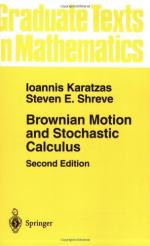|
This section contains 744 words (approx. 3 pages at 300 words per page) |

|
Brownian motion describes how very small solid particles, such as smoke particles or microscopic pollen particles, move when they are bombarded by the molecules surrounding them. This movement was first observed in 1827 by Scottish botanist Robert Brown (1173-1858). He saw in his microscope small pollen particles suspended in water. On closer inspection he noticed the pollen particles appeared to be jiggling about at high speed. It was suggested in 1863 that this motion was the result of millions of collisions between the solid pollen particles and the speeding molecules of the water. Albert Einstein turned his attention to the nature of this jiggling motion and the important outcome of his work was the calculation of the number of molecules in a standard volume of gas. This value had been unknown until that time.
The first question in considering Brownian motion is...
|
This section contains 744 words (approx. 3 pages at 300 words per page) |

|


